Business Process Model and Notation (BPMN) is a standard for visualizing and designing business processes. It uses various BPMN symbols to represent different elements in a process. BPMN is a key tool in business process mapping, enabling businesses to document and analyze their workflows for continuous improvement. Check out our guide on BPMN to learn about the Business Process and Modeling Notation in more detail. Here is a complete list of BPMN symbols along with their meanings.
What are BPMN Symbols
BPMN symbols are graphical elements used in BPMN diagrams to represent various aspects of business processes. These symbols provide a standardized and visual way to document, analyze, and communicate complex workflows and activities within an organization. BPMN symbols can be categorized into several main types based on their functions in visualizing business processes. Business process mapping, using these BPMN symbols, allows organizations to gain a clearer understanding of their workflows and identify areas for improvement.
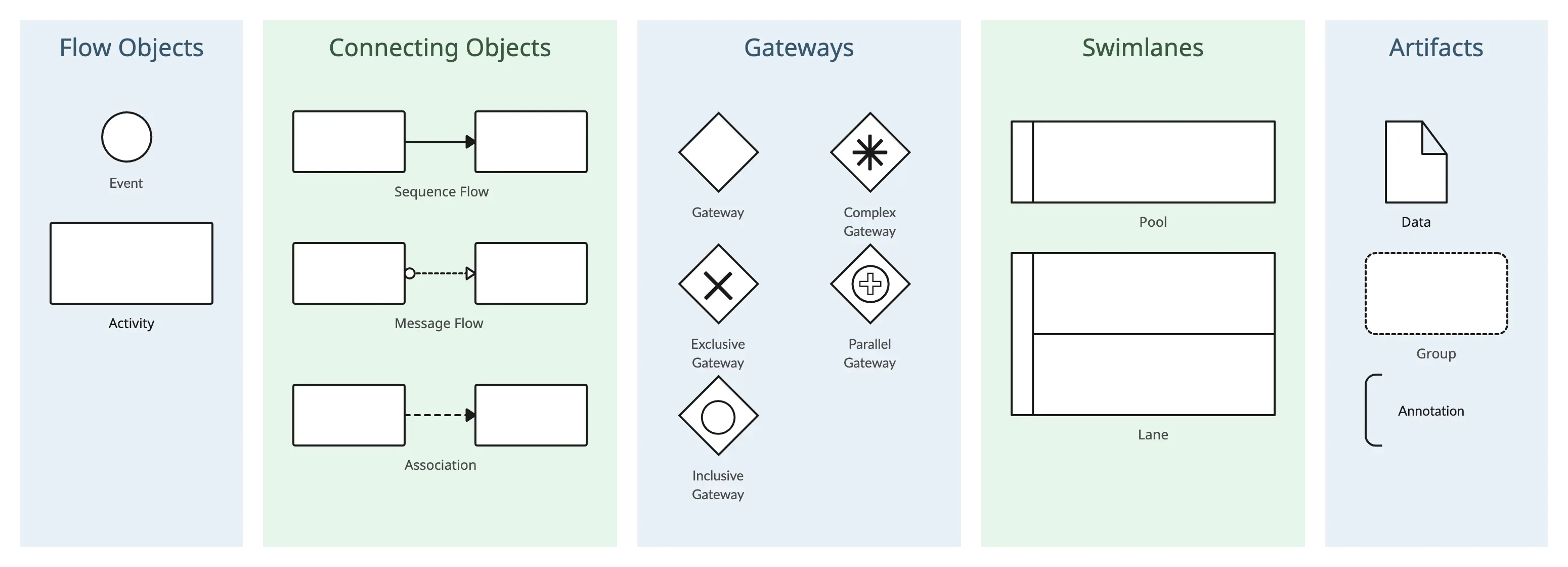
1. Flow Objects in BPMN Symbols
Flow objects are the essential components that form the backbone of BPMN (Business Process Model and Notation) diagrams. They are the graphical symbols used to represent the key activities, events, and decision points in a business process. These elements help visualize the sequence of operations, interactions, and conditions that drive a process from start to finish. BPMN flow objects allow process designers, analysts, and stakeholders to communicate the workflow in a standardized, intuitive way, ensuring that everyone involved has a clear understanding of how processes function and interconnect.
By utilizing flow objects, organizations can model both simple and complex processes with precision, identifying crucial touchpoints where decisions are made, activities are carried out, and events occur. This enables a deeper understanding of the process structure, highlights areas for optimization, and makes it easier to communicate process designs across teams and stakeholders. These BPMN symbols are fundamental for process improvement, automation, and streamlining workflows within businesses, offering clarity and consistency throughout process management.
Flow objects in BPMN are the core elements that define the flow of a business process. They include:
1. Events: Represent occurrences that trigger or change the process, depicted as circles.
2. Activities: Represent tasks or operations performed in the process, shown as rectangles.
3. Gateways: Decision points that control the flow based on conditions, represented by diamonds.
These flow objects work together to create a clear, logical representation of a process, helping stakeholders understand its sequence and decision-making logic.
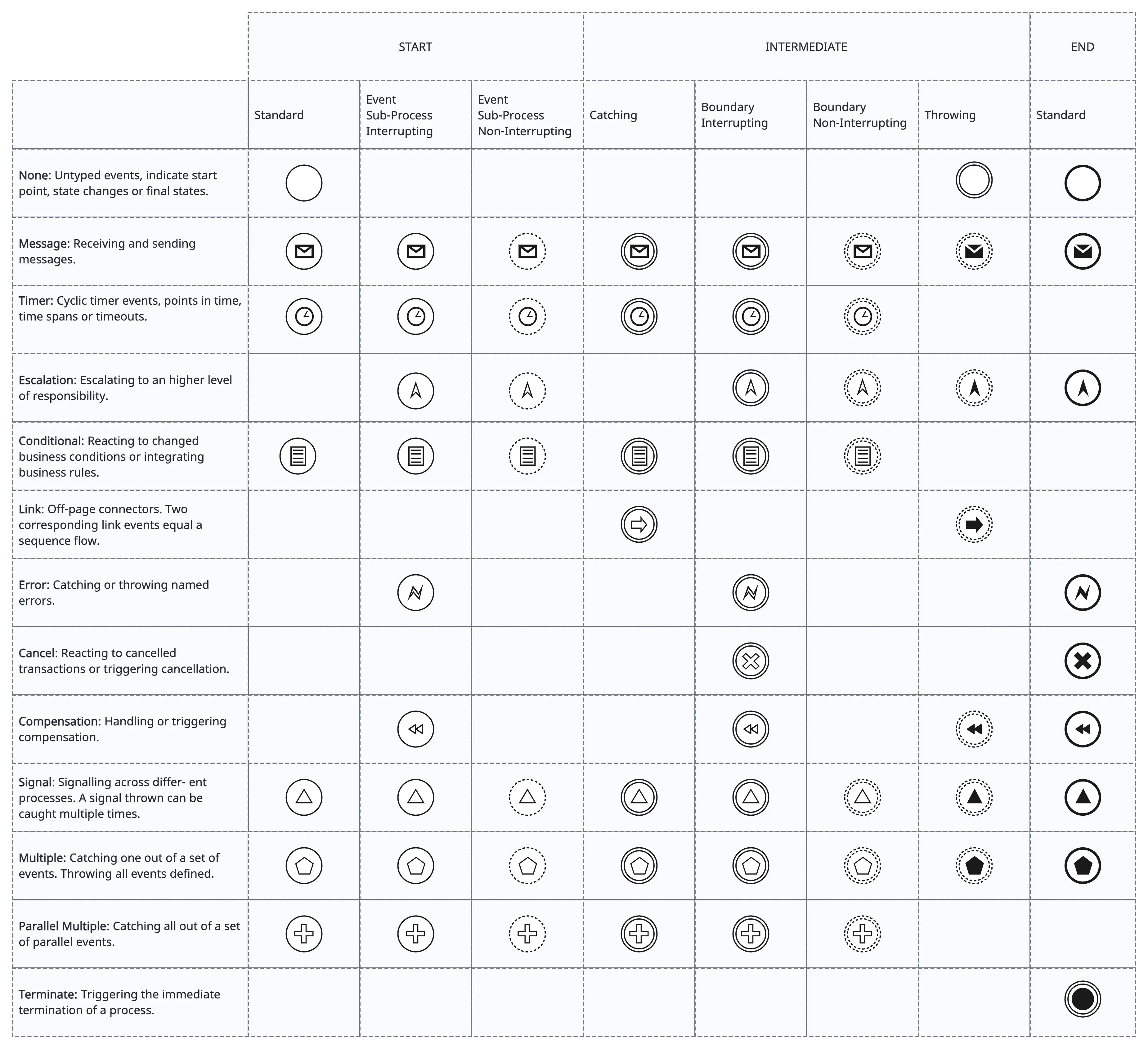
Events
Events are key elements that represent occurrences or states within a business process. Events play a crucial role in modeling the flow of activities and defining how the process responds to external stimuli or triggers. There are three main types of BPMN events: Start Events, Intermediate Events, and End Events.
Start Events
Start events mark the beginning of a process. They represent the points at which a process is initiated. There are several types of start events, including:
- None start event: The process starts immediately without an external trigger.
- Message start event: The process is triggered by the receipt of a message.
- Timer start event: The process is initiated based on a predefined time or timer.
- Conditional start event: The process starts based on a specified condition.
- Signal start event: The process begins in response to the receipt of a signal.
- Multiple start events: Multiple events can trigger the start of the process, and any one of them can initiate the process.
Intermediate Events
Intermediate events occur between the start and end of a process. They represent points where something happens during the execution of the process.
- Message intermediate event: Represents the receipt or sending of a message during the process.
- Timer intermediate event: Represents an intermediate point in the process based on a timer or specific time.
- Conditional intermediate event: Represents an intermediate point based on a specified condition.
- Signal intermediate event: Represents the occurrence of a signal during the process.
- Link intermediate event: Represents the use of a link to connect different parts of the process.
- Compensation intermediate event: Represents the initiation of compensation activities in case of an error or exception.
- Error intermediate event: Represents an error condition during the process.
End Events
End events mark the conclusion or completion of a process. They represent the points at which the process finishes its execution. There are several types of end events, including:
- None end event: The process concludes without any specific result.
- Message end event: The process concludes by sending a message.
- Error end event: The process concludes with an error condition.
- Terminate end event: The process is terminated abruptly.
- Signal end event: The process concludes in response to a signal.
- Multiple end event: Multiple end events can be used to indicate various possible outcomes or results.
Activities
Activities are represented by various symbols to depict different types of work or tasks within a business process. The main activity BPMN symbols are:

- Task: Represents a unit of work that needs to be performed as part of the process. Tasks can be atomic (indivisible) or expanded into sub-processes.
- Sub-process: Represents a subprocess within the main process. Subprocesses allow for the decomposition of complex processes into smaller, more manageable components.
- Transaction: Represents a transactional subprocess, which is a specialized form of a subprocess. It makes sure that all enclosed activities are completed successfully or rolled back in case of an error.
- Call activity: Represents a call to a global process or a reusable subprocess defined outside of the current process. It is used for modularizing processes and reusing them in different contexts.
Activity Markers
Activity markers are BPMN symbols or icons added to BPMN activity shapes to convey additional information about the nature or behavior of the activity.
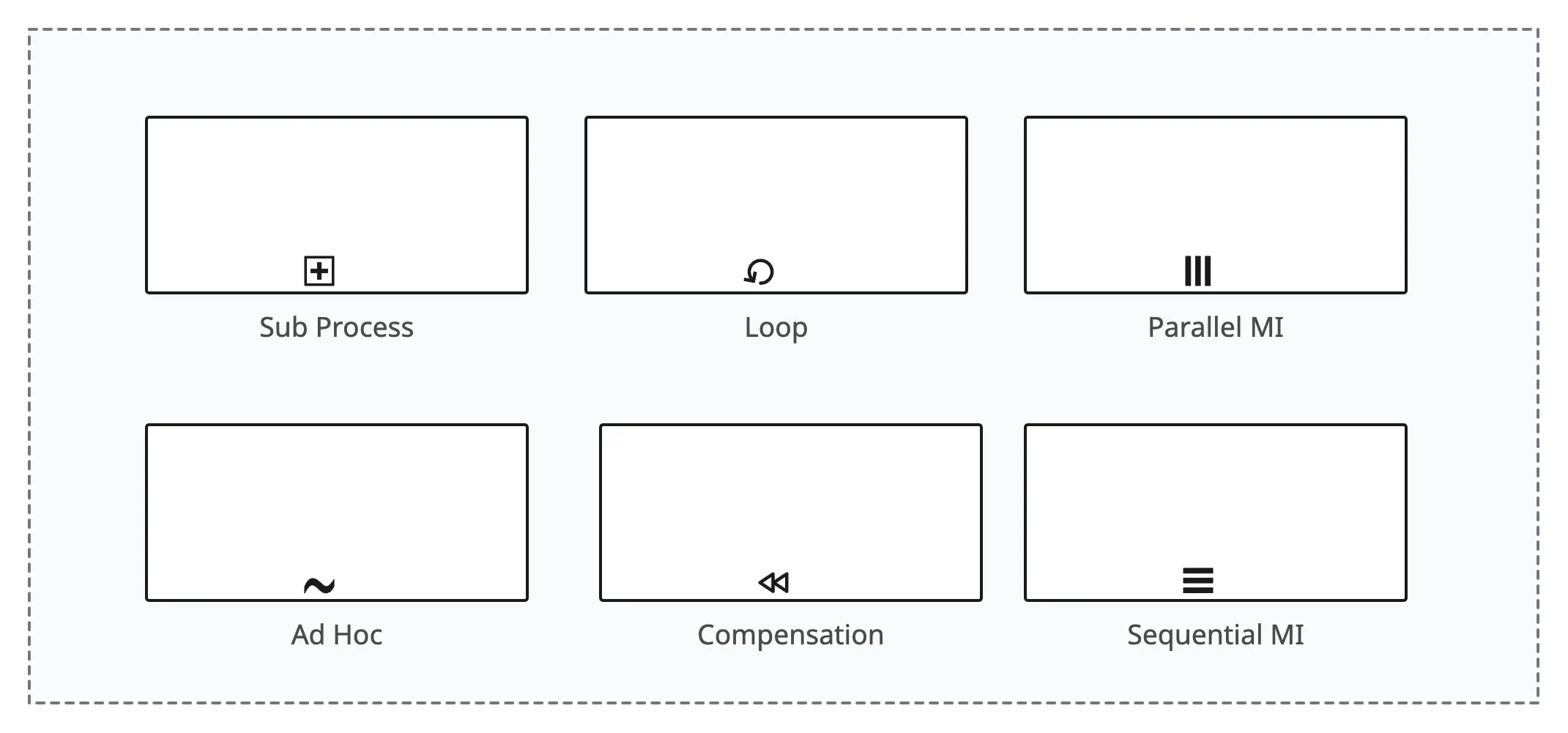
- Loop marker: Indicates that the associated activity or subprocess should be repeated in a loop until a certain condition is met.
- Parallel marker: Indicates that the tasks within a subprocess can be executed in parallel.
- Ad hoc marker: Indicates that the tasks within the subprocess can be performed in any order or repeated as needed.
- Compensation marker: Indicates that the activity is a compensation activity, and it is associated with handling compensation for a previous activity in case of an error.
- Sequential marker: Indicates that the tasks within a subprocess should be executed sequentially.
Task Types
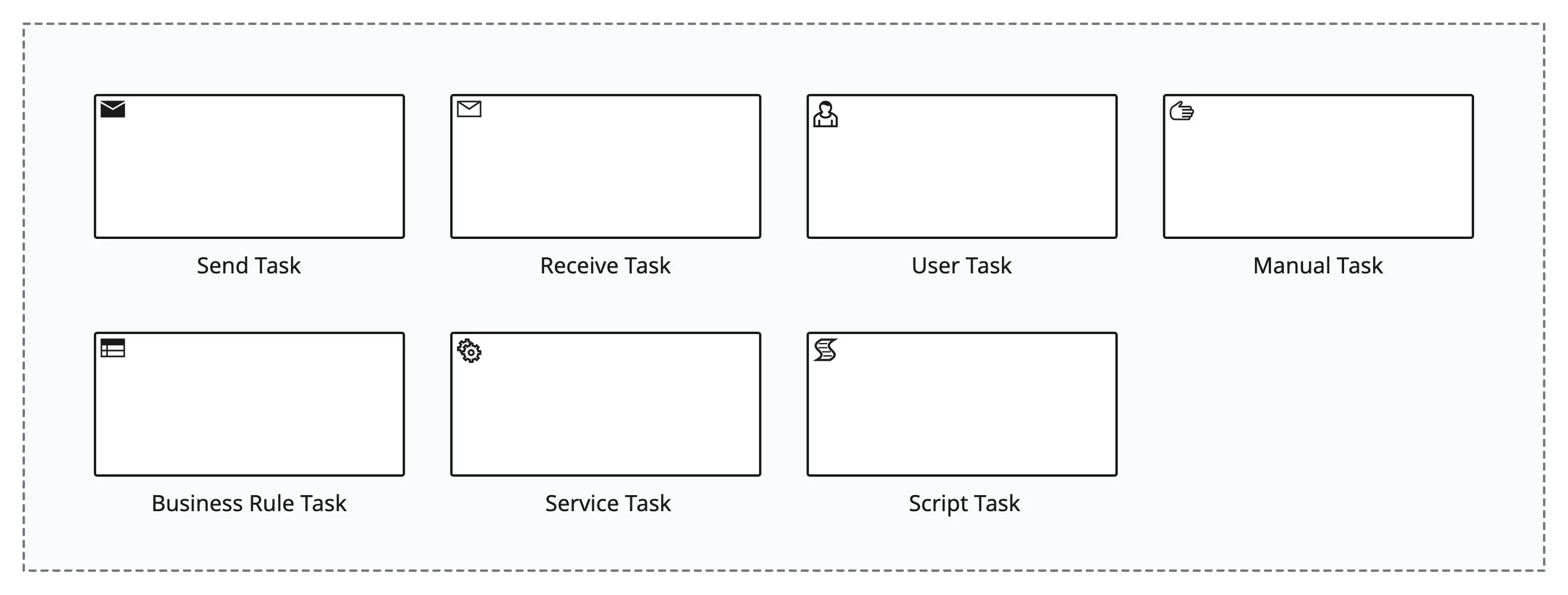
- Send task: Represents a task that sends a message or signal to another process or participant.
- Receive task: Represents a task that waits for a message or signal to be received before proceeding.
- User task: Represents a task that requires human interaction. It is typically performed by a knowledge worker or end-user.
- Manual task: Represents a task that is performed manually by a human, but it is less specific than a User Task.
- Business rule task: Represents a task that is based on business rules or decision logic. It is often used for decision-making within the process.
- Service task: Represents an automated task that is performed by a software service or system. It may involve communication with external systems.
- Script task: Represents a task that is performed based on a predefined script or script language. It is typically automated.
2. Gateways
Gateways in BPMN are crucial elements used to control the flow of a business process by defining decision points. They are represented as diamonds and help model situations where the process flow diverges or converges based on specific conditions, events, or rules. Gateways allow for the creation of different process paths, enabling the process to adapt to varying scenarios. These decision points are essential for managing complexity within business processes, ensuring that the correct sequence of tasks is followed depending on the process conditions. Gateways can represent parallel, conditional, or exclusive paths, allowing for flexibility and clarity in process modeling.
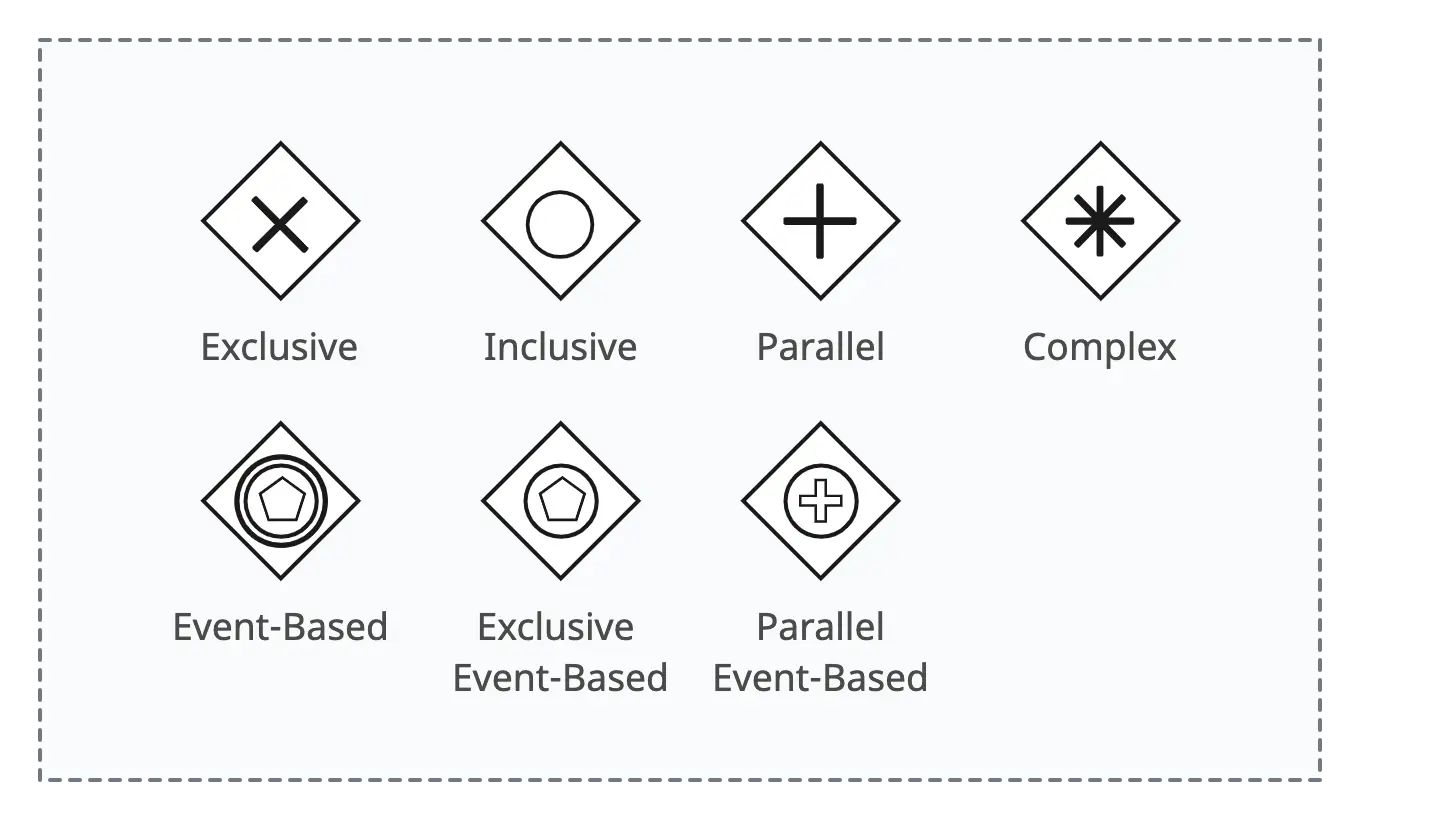
- Exclusive gateway: Represents a decision point where only one of the outgoing paths can be taken. The decision is based on evaluating conditions associated with each outgoing sequence flow.
- Inclusive gateway: Represents a decision point where multiple paths can be taken based on evaluating conditions associated with each outgoing sequence flow. All paths with true conditions are taken.
- Parallel gateway: Represents a point where multiple paths can be taken simultaneously without evaluating conditions. It is used for parallel execution of activities.
- Complex gateway: Represents a more complex decision point where conditions and rules may involve a combination of logical operators. It allows for more sophisticated decision-making logic.
- Event-based gateway: Represents a decision point based on events. It is used when the process flow depends on the occurrence of specific events, such as receiving a message or a timer event.
- Exclusive event-based gateway: Similar to the event-based gateway, but enforces exclusive decision-making based on events. Only one path can be taken, depending on the first event to occur.
- Parallel event-based gateway: The occurrence of all subsequent events starts a new process instance.
3. Artifacts
Artifacts in BPMN are additional elements that provide supplementary information to a process diagram without directly influencing the flow of the process. Artifacts are used to add context, clarify details, and document various aspects of the process, offering a deeper understanding of how processes operate. While flow objects like events, activities, and gateways define the core structure and flow of the process, artifacts are used to enhance communication and provide extra documentation.
Artifacts can be used for various purposes, such as labeling tasks, documenting data stores, or noting important rules and information that may affect the process but do not alter the primary flow. These include elements like Data Objects, Groups, and Annotations. Each artifact serves a distinct role, contributing to the clarity and completeness of the BPMN diagram, making it more insightful and easier to interpret for stakeholders.
Data Symbols
Data BPMN symbols represent the flow and handling of data within a business process. They help in visualizing how data is created, used, stored, and transferred throughout the process.
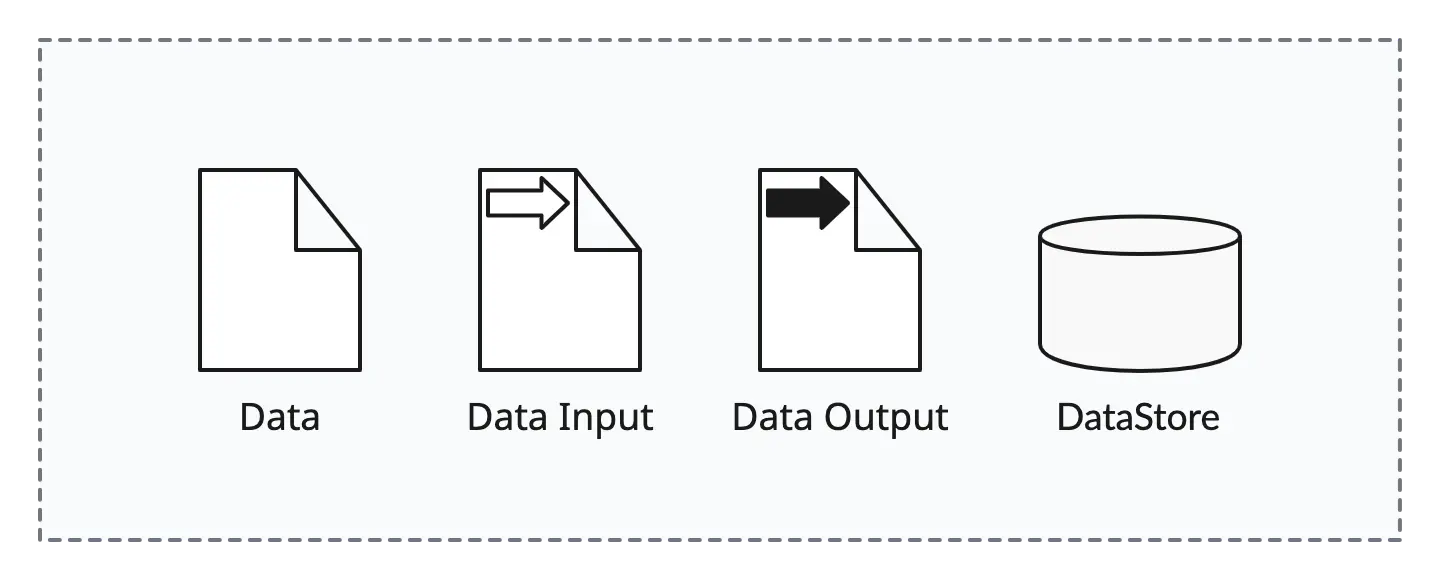
- Data object: Represents data or information used or produced within a process. It helps illustrate the flow of data between activities.
- Data input/output: Represents the input or output of data from an activity. It indicates the flow of data into or out of a task or subprocess.
- Data store: Represents a place where data is stored during the execution of a process. It can be a physical repository or a database.
Group, Annotation, & Association

- Group: Groups related elements in a diagram. It is often used to visually organize and highlight specific sections of the process.
- Annotation: Provides additional information or comments to enhance the understanding of the process. Annotations are often used to add explanatory notes or documentation.
- Association: Connects artifacts, data objects, or text annotations to flow objects, indicating a relationship or dependency. Associations help in clarifying connections between elements.
4. Conversations
Conversations are used to model interactions and communications between participants in a business process. Conversations provide a high-level view of how different participants, typically represented as Pools in BPMN diagrams, exchange messages and collaborate to achieve a common goal.
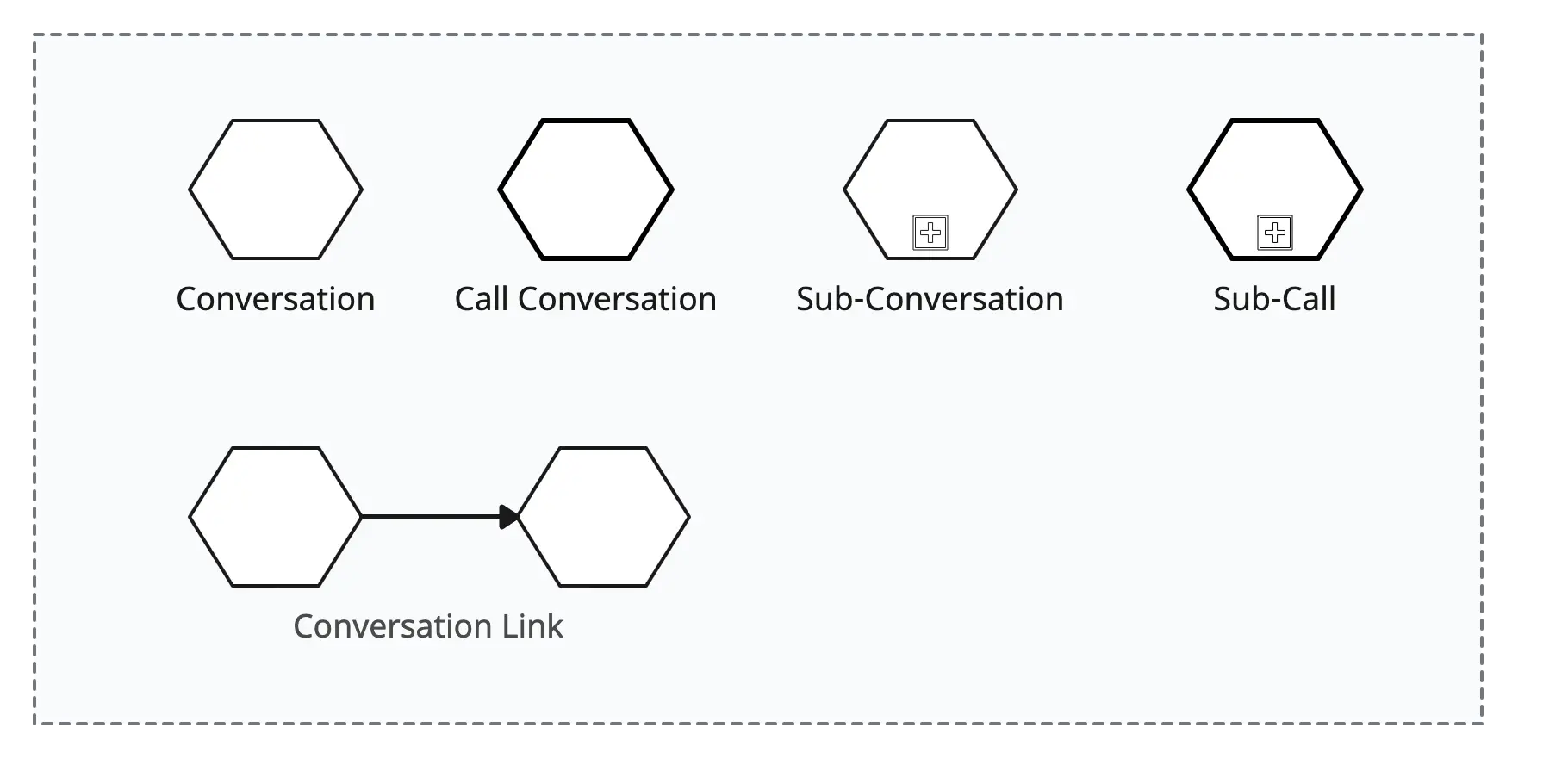
- Conversation: Represents a conversation or communication between different participants in a business process. It provides an overall context for the interactions.
- Sub-conversation: Represents a more detailed or nested conversation within a larger conversation. It is used to provide a more granular view of interactions within a specific part of the overall process.
- Call conversation: Represents a call or sub-process that is initiated from within a conversation to represent a more detailed interaction or subprocess.
- Conversation link: Represents a connection or link between different parts of a conversation or between different participants. It indicates that there is a relationship or interaction between them.
5. Connecting Objects
Connecting Objects in BPMN are essential elements that define the relationships and flow between different process elements such as activities, events, and gateways. These BPMN symbols act as the “links” that connect the flow objects, ensuring the business process is logically structured and easy to follow. They play a crucial role in illustrating how different steps or decisions are interconnected, helping to visualize the sequence and dependencies of tasks within the process.
Connecting objects provide clarity and direction to the BPMN diagram, ensuring that all elements are properly aligned and that the flow of the process is consistent and accurate. The main types of connecting objects in BPMN are Sequence Flows, Message Flows, and Associations, each serving a specific purpose in modeling how information and actions are transferred between different elements of the process.
Sequence Flow
Represents the order in which activities or events are performed within a process. It connects two flow objects, indicating the direction of process flow.

Message Flow
Represents the flow of messages between participants or pools in a process. It illustrates the communication paths between different entities.
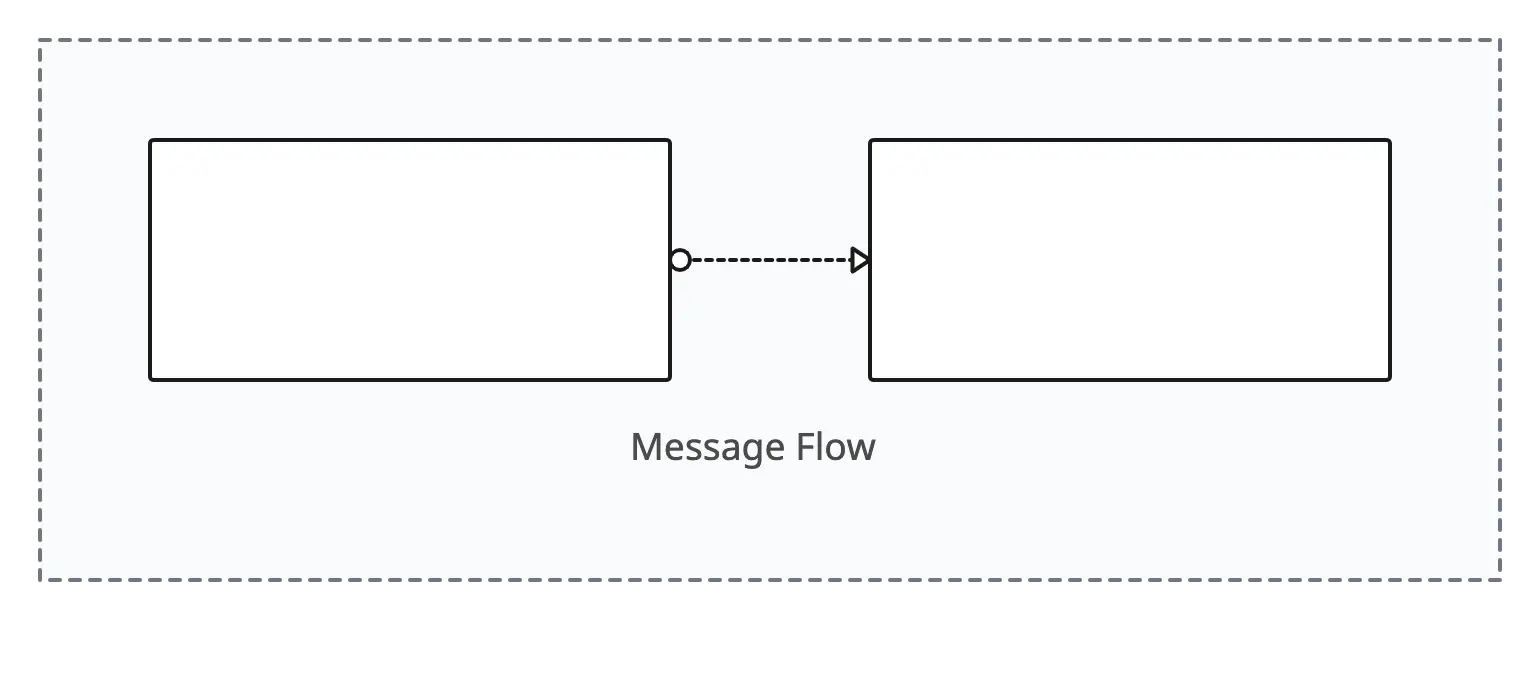
Conditional Flow
Represents a flow in the process that is taken based on a specific condition or decision.

Default Flow
Default flow is the default branch to be chosen if all other conditions evaluate to false.

6. Swimlanes
Swimlanes in BPMN are a key visual element used to organize and categorize activities within a business process. Here’s how they work:
Representation: Swimlanes are typically depicted as horizontal or vertical partitions within a BPMN diagram.
Purpose: They separate the process into distinct sections, each corresponding to a specific participant, role, department, or system involved in the process.
Function: Swimlanes clearly show who is responsible for each task or activity, helping to map out the responsibilities and interactions across different stakeholders.
Benefit: This visual separation enhances clarity, improves collaboration, and makes the process flow easier to understand by defining clear boundaries between different participants or departments. Using swimlanes ensures greater transparency, accountability, and efficiency, providing a clear representation of how the process is executed across various roles and systems.
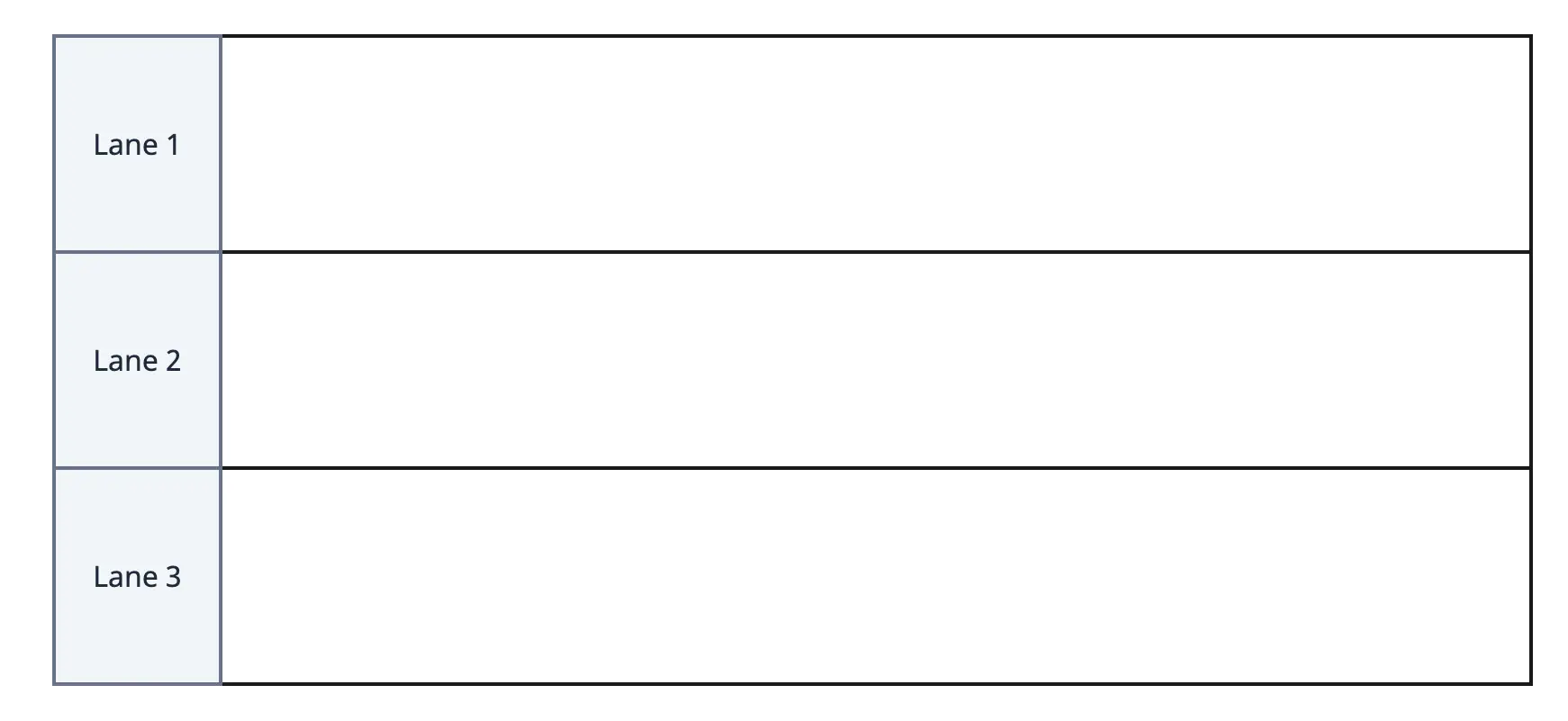
Pools
Pools are used to represent separate organizational entities or participants in a process. Each pool can contain its own set of activities and processes, and communication between pools is depicted using message flows.
Lanes
Lanes are subdivisions within a pool and are used to organize and categorize activities further. Each lane typically corresponds to a specific role, department, or system within the organizational entity represented by the pool.
7. Choreographies
Choreographies in BPMN model the interactions and collaborations between multiple participants or entities in a business process. Unlike traditional process diagrams, which focus on a single participant’s internal flow, choreographies emphasize external communication and coordination. Key features include:
Participant Interaction: Models how different participants communicate with each other.
Message Exchange: Shows the flow of messages between participants, triggering actions or responses.
Collaboration: Defines roles and responsibilities for each participant.
Decentralized Control: Highlights that no single participant controls the process.
Visualizing Communication Patterns: Depicts how information is exchanged between participants.
Use Cases: Ideal for inter-organizational or external service interactions. Choreography diagrams offer a clear view of multi-party communication, optimizing cross-organizational workflows.
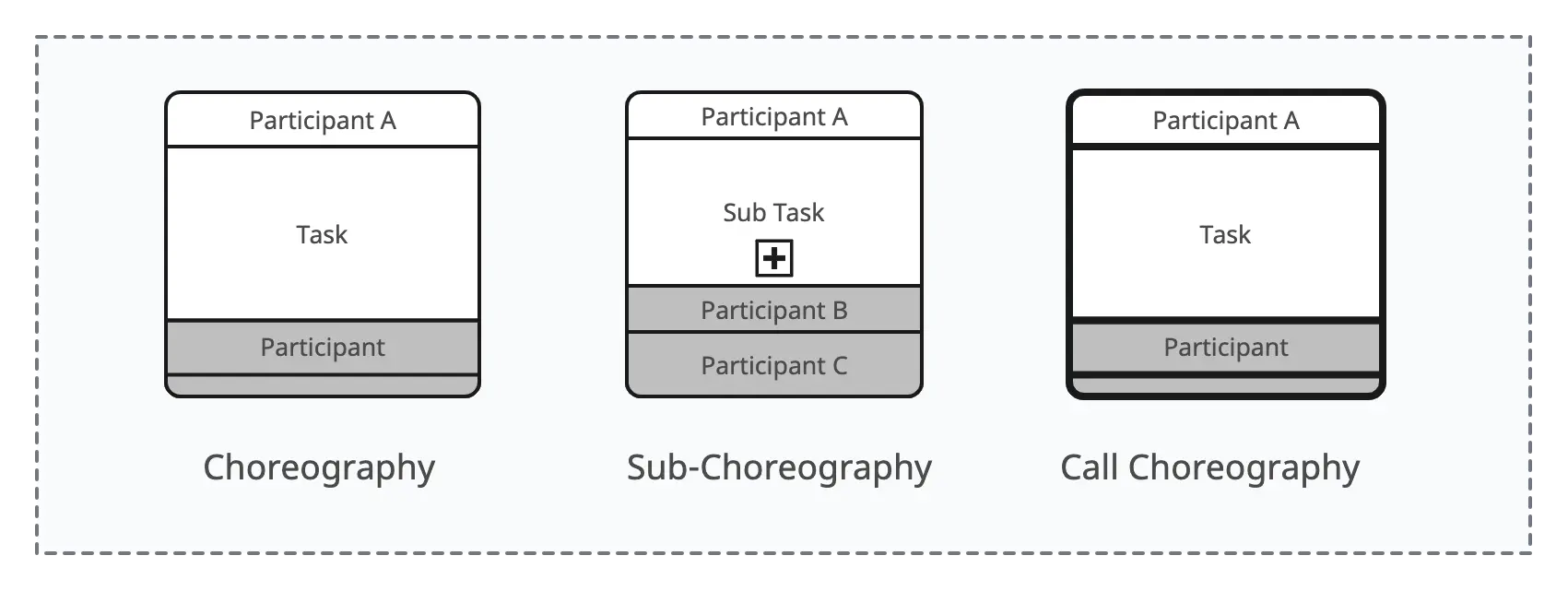
Tips for Memorizing BPMN symbols
1. Understand the Purpose: Know the role of each BPMN symbol in the process.
2. Use Mnemonics: Create easy associations for each BPMN symbol.
3. Group BPMN Symbols: Categorize BPMN symbols into Flow Objects, Connecting Objects, and Artifacts for easier learning.
4. Practice Regularly: Draw BPMN symbols and diagrams to reinforce memory.
5. Use Flashcards: Review BPMN symbols with flashcards for quick recall.
6. Visual Learning: Use cheat sheets or tutorials to familiarize yourself with BPMN symbols.
7. Learn Through Scenarios: Connect BPMN symbols with real-world business scenarios.
8. Leverage Tools: Use tools like Creately for hands-on practice.
Regular practice and visual associations help make BPMN symbols easier to memorize and apply.
Helpful Resources
Visualize, analyze, and improve organizational processes on a single, connected workspace.
Fine-tuning your business process? Planning a project? Organizing your assignment? Whatever the situation, mind maps are a great way to visualize the process and execute it smoothly.
Use our powerful swimlane diagram maker to create business process diagrams online.
Identify waste and inefficiencies in your existing processes and collaborate to develop solutions for improvement using our advanced value stream mapping software.
Use BPMN Symbols with Creately
Now that you have a comprehensive idea of all the BPMN symbols, get started on creating a BPMN diagram. Creately offers a complete shape library of standard BPMN 2.0 shapes listed above for you to create accurate BPMN diagrams to represent your business processes. Effectively streamline visualizing processes with your team with Creately’s intuitive drawing tools and real-time collaboration.
Creately’s Advanced BPMN Features
Automatic Database Creation
Creately’s BPMN tool automatically creates a centralized database as users drag and drop BPMN shapes onto the canvas. Each shape becomes data-linked, allowing updates in one diagram to reflect instantly across all related diagrams. This feature promotes consistency, data integrity, and efficiency, making it ideal for complex BPMN projects by reducing manual updates and supporting seamless reuse of processes across projects.
Advanced Modeling Capability
Creately simplifies BPMN diagram management with centralized modeling, where process models are stored in a central database. Updates to any process are instantly reflected across all related diagrams, eliminating the need for manual updates and supporting reusability across multiple diagrams or views, making long-term projects more efficient.
Create Live Maps
Creately enables “living” BPMN maps that stay updated with evolving processes. Through version control and regular review sessions, these maps remain accurate and relevant, allowing teams to make real-time adjustments and maintain consistent workflows.
Enhanced Collaboration and Reusability
Shared workspaces in Creately allow teams to collaborate on BPMN diagrams in real-time, keeping maps accurate and aligned across members. Defined processes can be reused in various diagrams, promoting consistency across projects without requiring re-creation.
Customization and Data Integration
Creately provides customizable BPMN diagrams with tailored shapes, colors, and styling options. Data integration allows users to embed links, files, and specific details within diagram shapes, keeping essential information organized and accessible.
Automation and Real-Time Updates
Creately supports automation, speeding up diagram creation and updates. Features like data-driven diagram generation and bulk updates streamline large-scale BPMN projects, ensuring diagrams reflect the latest changes promptly and accurately.





